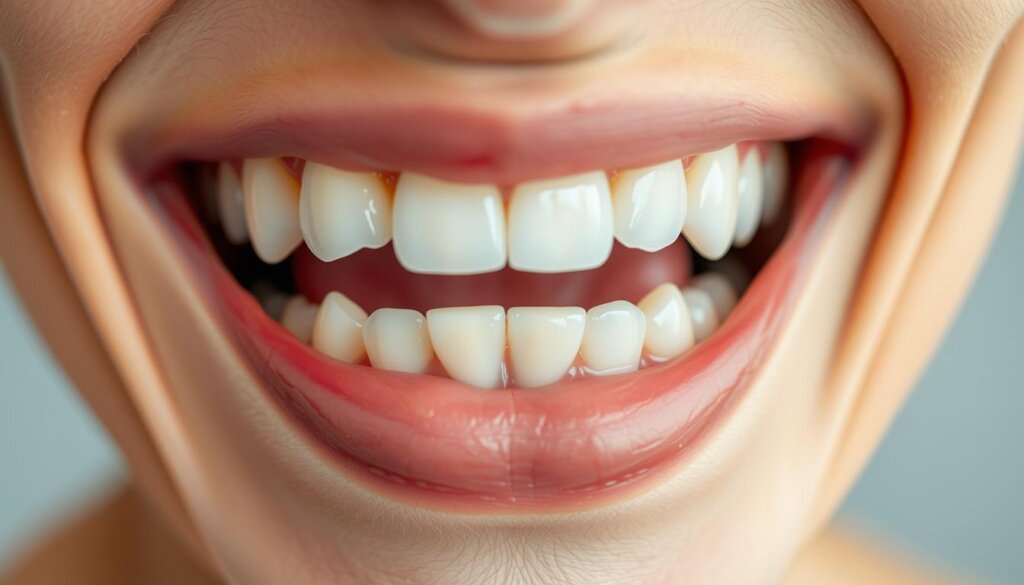Do I Need a Dental Exam If My Teeth Feel Fine?
Recent data from the American Dental Association shows nearly one-third of adults skip their yearly check-ups, even when they feel no discomfort. This raises an important question: Do I need a dental exam if my teeth feel fine?
Some early dental problems don’t show symptoms until they become serious. Small gum inflammation or tiny fractures can go unnoticed without a professional check. Finding these issues early can prevent the need for more serious treatments and keep your teeth healthy for longer.
Key Takeaways
- Early-stage oral problems may not cause pain or visible changes.
- Regular check-ups help detect tiny fractures and gum inflammation.
- Preventive visits often lower the risk of more invasive treatments.
- Dentists can spot developing cavities long before symptoms appear.
- Routine exams protect overall well-being as much as they do teeth.
Understanding the Importance of Dental Exams
Good oral health starts with regular visits to the dentist. These visits help catch problems early, like cavities or gum issues. This way, your teeth stay strong and your smile stays bright.
Dentists check your teeth, gums, and fillings. They might use X-rays to find hidden problems. They also watch how your teeth and jaw grow, which affects how you chew and speak.
What Happens During a Dental Exam?
During a dental exam, your dentist looks for plaque and checks each tooth. They might clean your teeth if they find plaque. They also:
- Check your gums
- Look at your dental history
- Find and fix small problems early
Why Regular Check-ups Matter
Going to the dentist regularly helps prevent serious problems. Catching small issues early means you won’t need big fixes later. Studies show that regular dental visits keep your gums healthy and your teeth strong.
| Exam Focus | Goal | Outcome |
|---|---|---|
| Tooth Inspection | Locate decay or fractures | Targeted treatment |
| Gum Check | Evaluate tissue condition | Reduced risk of disease |
Signs of Oral Health Issues
Early detection is key to keeping teeth strong. Small signs can tell us a lot about what’s happening in our mouths. Even slight changes in how we chew or a bit of discomfort can mean trouble.
Acting fast can help keep our oral health in top shape.
Common Symptoms to Watch For
Constant pain can mean nerves are irritated. Bleeding gums when we brush or floss often mean inflamed gums. Sores that don’t heal quickly are a big worry.
Changes in how our teeth fit together can also be a sign of trouble. And feeling pain when we eat or drink something hot or cold can show problems with our teeth.
The Silent Signs of Dental Problems
Many problems don’t hurt right away. Small cavities or early gum disease can sneak up on us. And grinding or clenching our teeth can chip enamel and hurt our jaw.
Catching these small signs early can help us and our doctors keep our oral health in great shape.
| Indicator | Possible Issue |
|---|---|
| Bleeding Gums | Potential Gum Inflammation |
| Frequent Mouth Ulcers | Bacterial or Viral Infection |
| Excessive Grinding | Damage to Enamel and Jaw Strain |
The Role of Preventive Care
Acting early can prevent big problems later. This means keeping up with oral hygiene and protecting teeth. It’s a smart way to save money and stay healthy over time.
How Preventive Care Protects Your Teeth
Fluoride treatments make teeth stronger. Dental sealants protect areas where bacteria can hide. Brushing with ADA-approved toothpaste removes plaque before it causes trouble. Sticking to preventive care can avoid costly treatments and keep you healthy.
| Common Preventive Tools | Key Benefits |
|---|---|
| Brushing & Flossing | Clears away plaque and debris |
| Dental Sealants | Shields biting surfaces from decay |
| Fluoride Applications | Reinforces enamel against acid attacks |
| Professional Cleanings | Identifies early signs and prevents buildup |
Importance of Early Detection
Catching small problems early makes treatment easier and cheaper. It also means less pain and quicker healing. Finding issues early boosts your health and confidence.
Frequency of Dental Visits
Regular check-ups are key to keeping your mouth healthy. Seeing your dentist regularly helps catch small problems early. This keeps your smile bright for longer.
Going to the dentist often shows how important dental care is. It also helps fix any issues quickly.
How Often Should You See a Dentist?
Most people should visit the dentist once or twice a year. If you often get cavities or gum problems, you might need to go more often. Regular visits help your dentist keep your teeth in top shape.
Factors Influencing Visit Frequency
Some people are more likely to get cavities or gum disease because of their genes. Smoking can make healing harder. If you have diabetes, your teeth might be more at risk too.
How often you should see a dentist depends on:
- Medical history
- Current oral health status
- Lifestyle habits
| Risk Group | Suggested Visit Range | Reason |
|---|---|---|
| Low Risk | 1-2 times/year | Basic preventive measures |
| Moderate Risk | 2-3 times/year | Extended monitoring of emerging issues |
| High Risk | As advised by specialist | Frequent intervention to support dental hygiene |
The Connection Between Oral Health and Overall Health
A healthy mouth shows a balanced body and supports daily life. Bacteria in plaque can affect tissues all over the body. That’s why getting professional help is key.
Link Between Dental Care and Systemic Health
Studies by the American Dental Association show that bacteria from gum infections can get into the blood. This can cause inflammation in other parts of the body. Regular flossing and check-ups can lower the risk of serious health problems.
Oral Health’s Impact on Chronic Conditions
Good oral health helps manage heart disease and diabetes. Inflamed gums can make it harder to control blood sugar and harm the heart. Taking care of your mouth with regular dental visits can help prevent these issues and improve health.
Cost Considerations for Dental Exams
Cost is a big factor in deciding when to go to the dentist. Some people worry about the cost of regular visits. But, with a little planning, you can make it more affordable.
Are Dental Check-ups Expensive?
Many think dental exams are pricey. But, the American Dental Association says to check your insurance and talk to your dentist about costs. Many offices work with insurance and offer payment plans. This makes regular dental care more affordable.
The Long-term Savings of Preventive Care
Early dental visits can catch small problems before they get big. A small filling or cleaning is cheaper than a big surgery. Taking care of your teeth early can save you money in the long run.
Here are some ways to save:
- Check your insurance for dental visits
- Ask about payment plans if needed
- Stick to the recommended schedule for dental care
Going to the dentist regularly can prevent big problems. It’s good for your teeth and your wallet. It follows the dental exam recommendations and keeps you healthy.
What to Expect in a Dental Examination
First, a visual check looks for trouble spots and sets a baseline. This method keeps teeth healthy and finds early signs of problems.
Typical Procedures During an Exam
Dentists check gums for signs of inflammation or bleeding. They measure around each tooth to check gum health. A gentle cleaning removes tartar and polishes surfaces for comfort.
Steps include:
- Identifying weak or decayed areas by gentle probing
- Discussing preventive measures like brushing techniques
- Evaluating bite alignment
The Use of X-rays in Dental Assessments
X-rays show hidden issues like bone loss or cavities. The radiation is low and safe for most people. Dentists may use protective covers when needed.
Examining these images helps plan for healthy teeth and stable oral health.
Dental Hygiene Best Practices
Keeping your mouth clean is key for your health. Experts say to brush with a soft-bristled brush and fluoride toothpaste. Aim for a 45-degree angle near your gums. This helps remove plaque and prevent gum inflammation.
Daily Routines for Healthy Teeth
Staying consistent with your oral care is important. Brushing your teeth twice a day is a good start. But, rinsing with antibacterial mouthwash can add extra protection.
Eating a balanced diet with less sugar helps your teeth too. These habits build a strong base for better dental care.
Incorporating Flossing in Your Routine
Brushing alone can’t reach all areas. Flossing gets rid of food and bacteria between your teeth. It’s recommended to floss every day to control plaque.
Flossing is a big part of keeping your teeth healthy. It follows the advice of dental professionals for a clean mouth.
The Role of Technology in Dental Care
New tools change how dentists work. They give patients real-time info and help dentists work faster. Could new scans and systems change how we care for our teeth?
Digital X-rays are now used in dentistry. They cut down on radiation and make it easier to see problems. Lasers find cavities that are hard to see. AI helps doctors make better choices by looking at pictures.
Advances in Dental Technology
Dentists use digital scanners to get 3D images of teeth. This means no more uncomfortable molds. CAD tools make custom dental work that fits perfectly. Cameras show patients what’s wrong, making it easier to talk about problems.
How Technology Enhances Patient Care
New devices make treatments easier and help prevent problems. They make care more personal, with less pain and quicker fixes. The main benefits are:
- More accurate treatments
- Quicker procedures
- Better teamwork between patients and doctors
This mix of new tech and proven methods makes care better and more satisfying for everyone.
The Importance of Patient Communication
Open dialogue leads to better treatment plans and builds trust. When patients share updates, changes in medication, or daily habits, dentists can prepare for issues. This way, dentists can tailor preventive care to meet individual needs, leading to better dental health in the long run.
Discussing Concerns with Your Dentist
Talking openly about sensitivities or nervousness can lead to solutions like sedation dentistry. Dentists can explain procedures in detail beforehand. This makes patients feel more at ease, encouraging them to ask questions and address concerns.
Clear conversations lead to more accurate diagnoses and better satisfaction with treatment plans.
How to Be Proactive in Your Oral Health Care
Being aware of changes in oral health habits is key. Sharing new symptoms, changes in diet, or stress can help dentists focus on specific areas. Patients who regularly share updates and ask for advice show they are actively involved in their care.
This approach supports a healthier mouth and teeth over time.
Common Misconceptions about Dental Exams
Many people skip routine dental visits because of wrong ideas about teeth health. They might think brushing is enough or ignore warning signs. Knowing the truth can lead to more visits and better dental care.
Dentists and experts, like those from the American Dental Association, push for early checks. Yet, myths like cleaning harming teeth or bleeding from flossing are common. These myths can stop people from getting help early.
Myths vs. Facts: Dental Health
Clearing up myths is key. Myths about enamel damage and hidden decay can hinder prevention. Studies show that scaling, when done right, protects teeth. Early dental visits can catch problems before they get worse.
| Myth | Fact |
|---|---|
| Professional cleaning weakens enamel | Proper scaling helps protect tooth integrity |
| Bleeding gums are always normal | Bleeding can be a warning sign of gum disease |
| Tooth decay is always obvious | Damage can progress silently without pain |
Why Fears Can Hinder Dental Care
Fear often keeps people from getting dental exams on time. Some are scared of pain, but new ways to reduce it exist. Talking openly and sharing facts can help ease worries and lead to better dental health.
Making an Informed Decision
Many people wonder if a small pain in their gums is serious. It could be just a minor irritation or the start of a bigger problem. Knowing the signs and thinking about long-term health is key.
Weighing the Benefits of Dental Visits
Regular dental check-ups can catch small issues before they get worse. Experts say early detection is a big plus. Cleanings help remove bacteria that can cause infections.
Some people feel better after a visit because of the care and advice they get. Going to the dentist can also teach you how to keep your mouth healthy.
Knowing When to Seek Help
Signs like constant soreness, bleeding, or lasting sensitivity are warning signs. Catching these early can prevent bigger problems. Being aware of these signs helps you make smart choices about when to see a dentist.
Spotting these signs early can avoid more serious treatments later on. It’s all about being proactive with your dental health.
Conclusion: Prioritize Your Oral Health
Many people think they have good oral health if they don’t feel pain. But, problems can hide and grow without being noticed. That’s why getting a routine dental exam is so important.
X-rays taken twice a year can show hidden issues. They reveal problems early, before they get worse.
Final Thoughts on Dental Exams
Dental exams are key to keeping teeth and the body healthy. They help prevent decay and infections. These can affect your overall health.
At times, dental exams can even spot signs of chronic diseases. This leads to early treatment.
Encouragement for Regular Dental Care
Regular dental visits are essential for a healthy smile at any age. They can save money by avoiding costly treatments later. For more on how often to visit the dentist, check this page.
Sticking to regular dental exams leads to a confident smile. It also ensures better health in the long run.



